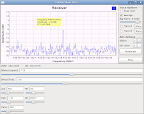Today I felt like doing an experiment that is not quite on my TODO list – a binaural CW receiver. A binaural CW receiver is a receiver that gives a spatial feeling while you are tuning. As I understand it, you have to use stereo where the signals move from one side to the other as you tune and are in the middle when you are tuned to the frequency.
Radios
Articles and blogs about radio receivers and transmitters. Both commercial off the shelf radios and home made DIY experiments by Alexandru Csete OZ9AEC.
Frequency xlating filter vs. complex multiplication
When I upgraded the simple GNU Radio receiver to single side band, I decided to separate the band pass filter and the frequency xlating filter and the frequency xlating filter got equipped with a wide low pass filter instead. The low pass filter is useful but really not important. Therefore, I decided to replace the frequency xlating filter with a simple complex multiplication (aka. local oscillator) and thereby save some CPU cycles – I figured that removing a filter would save something.
Improved AGC for the simple SSB receiver
Few days ago I wrote about how I upgraded the simple double side band receiver implemented in the GNU Radio Companion to a simple single side band receiver. This initial implementation used some default values for the AGC attack and decay rates. These values were acceptable; however, I wanted to spend some time trying to find better values that would correspond to Fast, Medium and Slow AGC – just as we are used to in commercial radios.
Simple SSB Receiver in GNU Radio Companion
The simple SSB software defined radio receiver is now functional!
Few days ago I wrote about how to upgrade the simple double side band receiver to single side band. The modification was supposed to be very simple and involved changing the band pass filter from using real taps to use complex taps. The upgrade wasn’t quite as easy, though.
From double side band to single side band reception
 When I presented the Simple CW Receiver few weeks ago I also mentioned and demonstrated that it is actually a double side band receiver (it’s around 2:35 in the video). This is good for AM and FM, but can be very inconvenient for receiving CW and SSB (single side band). If the station we are trying to receive is surrounded by other stations on the neighbouring channels, these will interfere via the opposite side band. Therefore, it was time to look into single side band reception.
When I presented the Simple CW Receiver few weeks ago I also mentioned and demonstrated that it is actually a double side band receiver (it’s around 2:35 in the video). This is good for AM and FM, but can be very inconvenient for receiving CW and SSB (single side band). If the station we are trying to receive is surrounded by other stations on the neighbouring channels, these will interfere via the opposite side band. Therefore, it was time to look into single side band reception.
A simple way to get video in and out of GNU Radio
One of the things I want to do with GNU Radio and the USRP is video transmissions over radio. For this purpose I need a way to read video sources – including files, webcams and other video capture devices – and to display or save it on the other end.
I suppose the right way to do this is to create specific signal sources and sinks for GNU Radio. This can be done either by “direct access”, i.e. read the UVC device directly, or by using a higher level library like libvlc or the ffmpeg libraries (libav*). The latter has indeed been used for audio and the code is available from the Comprehensive GNU Radio Archive (CGRAN) under Mediatools.
For this experiment, however, I decided to try something simpler that that I can try and conclude within an evening: Use VLC as capture and playback applications and connect to GNU Radio using either the TCP or UDP interfaces.
WBX receiver sensitivity in CW
After finishing the initial “smoke tests” on the 5.6-5.9 GHz receiver setup – in particular the KU LNC 5659 C PRO down converter, we decided to measure the sensitivity of the WBX receiver over the whole range. We define sensitivity in this respect as the weakest CW signal that: Gives an SNR of at least … Read more
Successful first tests of the UNITEC-1 receiver setup
Today we carried out the first test campaign of the 5.6-5.9 GHz receiver setup consisting of the KU LNC 5659 C PRO low noise down-converter, USRP with WBX daughterboard and some GNU Radio software. Our plan was to test the receiver using the 5.76093 GHz signal from the OZ7IGY beacon. The results are as follows: … Read more
Simple CW Receiver V0.3
Just a quick note before I’m leaving to OZ7SAT for the smoke tests of the KU LNC 5659 C PRO low noise down converter – attached to the USRP+WBX. I had some time to improve on the simple CW receiver by adding the frequency translating filter to allow easy tuning within the sampled spectrum. This … Read more
OZ7IGY beacon with GNU Radio, USRP and WBX
I was playing with GNU Radio, the USRP and the WBX daughterboard tonight preparing for the tests of the 5.7/5.8 GHz receiver setup tomorrow. For some reason that I can not remember, I have decided to tune in to 432.471 MHz – the UHF frequency of the OZ7IGY beacon, which is located approximately 50 km … Read more